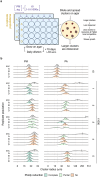This is a preprint.
Whole-genome duplication in the Multicellularity Long Term Evolution Experiment
- PMID: 38659912
- PMCID: PMC11042302
- DOI: 10.1101/2024.04.18.588554
Whole-genome duplication in the Multicellularity Long Term Evolution Experiment
Update in
-
Genome duplication in a long-term multicellularity evolution experiment.Nature. 2025 Mar;639(8055):691-699. doi: 10.1038/s41586-025-08689-6. Epub 2025 Mar 5. Nature. 2025. PMID: 40044858 Free PMC article.
Abstract
Whole-genome duplication (WGD) is widespread across eukaryotes and can promote adaptive evolution1-4. However, given the instability of newly-formed polyploid genomes5-7, understanding how WGDs arise in a population, persist, and underpin adaptations remains a challenge. Using our ongoing Multicellularity Long Term Evolution Experiment (MuLTEE)8, we show that diploid snowflake yeast (Saccharomyces cerevisiae) under selection for larger multicellular size rapidly undergo spontaneous WGD. From its origin within the first 50 days of the experiment, tetraploids persist for the next 950 days (nearly 5,000 generations, the current leading edge of our experiment) in ten replicate populations, despite being genomically unstable. Using synthetic reconstruction, biophysical modeling, and counter-selection experiments, we found that tetraploidy evolved because it confers immediate fitness benefits in this environment, by producing larger, longer cells that yield larger clusters. The same selective benefit also maintained tetraploidy over long evolutionary timescales, inhibiting the reversion to diploidy that is typically seen in laboratory evolution experiments. Once established, tetraploidy facilitated novel genetic routes for adaptation, playing a key role in the evolution of macroscopic multicellular size via the origin of evolutionarily conserved aneuploidy. These results provide unique empirical insights into the evolutionary dynamics and impacts of WGD, showing how it can initially arise due to its immediate adaptive benefits, be maintained by selection, and fuel long-term innovations by creating additional dimensions of heritable genetic variation.
Figures












References
Publication types
Grants and funding
LinkOut - more resources
Full Text Sources
